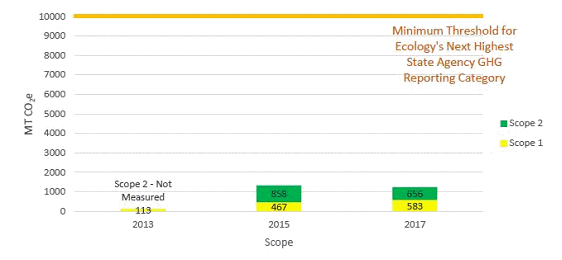Submitted by Port of Olympia
As part of its continuing focus on sustainability, the Port of Olympia has completed its 2017 greenhouse gas (GHG) emissions report. The report is an inventory of emissions generated by Port activities at its downtown, Lacey and airport facilities. The inventory, compiled per the Washington State Department of Ecology protocol, shows the Port has reduced its Scope 1 and Scope 2 CO2e emissions since 2015, maintaining a relatively small carbon footprint. As of 2017, Port activities were estimated to generate approximately 583 metric tons of Scope 1 carbon dioxide (MT CO2e) per year, an amount equivalent to approximately 23 American families. Under the State Agencies Climate Leadership Act, Washington State only requires annual monitoring and reporting for entities generating in excess of 10,000 MT CO2e per year.

The Port’s inventory examines both “Scope 1” and “Scope 2” emissions. Scope 1 emissions generally include energy “outputs” from equipment like boats, trucks and cars. Scope 2 emissions, not required to be monitored or reported under the State Agencies Climate Leadership Act, include energy “inputs” or energy used by structures and buildings. The recent study shows Scope 1 emissions are slightly up since the study was conducted in 2015, while Scope 2 emissions have decreased. The report author, Pioneer Technologies Corporation, attributes increases to a rebounding economy.
According to the Port’s Planning, Public Works & Environmental Director Rachael Jamison, completing the greenhouse gas inventory is just another step in a longer process to make the Port of Olympia one of the greenest Port’s in the country. “We were pleased to see our Scope 2 emissions drop, even after adding three new buildings in Lacey and a new fuel dock in Olympia. It is rewarding to see our continued efforts to manage and reduce emissions making a difference.”
While not required to monitor or report, the Port will identify opportunities to further reduce its carbon footprint. The Port has already begun to identify opportunities to increase its overall sustainability. Recent examples include the installation of solar panels at the Marine Terminal warehouse, converting to energy-efficient cargo yard lighting, and adoption of a stormwater management program and stormwater pollution prevention plan.
For information about Inventory, including presentations and reports, visit the Port’s website at http://www.portolympia.com/112/Environment.



















































